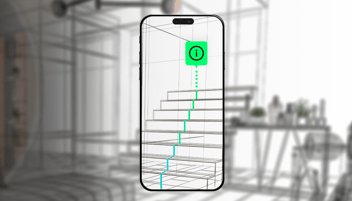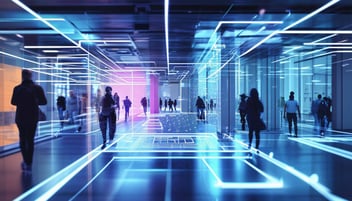< Back to the AR Wayfinding Guide
The 5 Best AR Wayfinding Technologies On The Market Right Now
Augmented reality (AR) is transforming how we navigate complex indoor environments like malls, airports, and museums. By blending digital overlays with real-world environments, augmented reality wayfinding provides intuitive solutions to guide users seamlessly through intricate spaces.
This article ranks the top five AR navigation technologies of 2025, counting down from the least effective to the best, based on their utility for indoor navigation.
- QR Codes
- Electromagnetic Fields
- Bluetooth Beacons
- Wi-Fi Triangulation
- Visual Positioning Systems (VPS)

5. QR Codes: A Basic Option for Indoor Wayfinding
QR codes are a low-cost solution for implementing indoor navigation. These static codes are placed in key locations, allowing users to scan them with their smartphones to access AR overlays that display directions or contextual information.
Use Cases
- Retail Stores: Direct customers to specific aisles or departments through AR prompts.
- Museums: Provide visitors with detailed exhibit information and directions.
- Warehouses: Help workers locate inventory efficiently with AR guidance tied to QR code scans.
Why It Ranks Last
While QR codes are simple and affordable, their static nature limits their utility for augmented reality navigation. Users must pause to scan codes at every checkpoint, disrupting the flow of navigation. While suitable for small-scale implementations, QR codes are less effective for seamless AR-based indoor wayfinding in larger venues.
4. Electromagnetic Fields: Niche but Precise Navigation
Electromagnetic field-based navigation uses a building’s natural magnetic anomalies to create unique “fingerprints” that AR systems can use for positioning. This enables accurate indoor navigation, especially in areas where other technologies struggle.
Use Cases
- Hospitals: Offer precise guidance for visitors and staff navigating large, multi-floor facilities.
- University Campuses: Help students locate lecture halls or administrative offices.
- Secure Facilities: Provide controlled indoor wayfinding without relying on additional infrastructure.
Why It’s Better but Still Limited
While electromagnetic fields offer highly accurate indoor navigation, their adoption remains limited due to the need for detailed mapping and specific device capabilities. They excel in environments that demand precision but are less scalable compared to other augmented reality wayfinding solutions.
3. Bluetooth Beacons: Affordable and Functional
Bluetooth beacons are one of the most established technologies for indoor wayfinding. These small devices transmit signals to smartphones, enabling proximity-based augmented reality navigation that guides users through indoor spaces.
Use Cases
- Shopping Malls: Provide AR navigation to stores, restaurants, and event areas.
- Airports: Help travelers locate check-in counters, gates, and baggage claim areas.
- Conference Centers: Direct attendees to exhibition halls or breakout sessions.
Why It’s Middle-of-the-Road
Bluetooth beacons are cost-effective and easy to deploy, making them a practical choice for large-scale indoor wayfinding. However, signal interference and ongoing maintenance requirements (e.g., battery replacement) are drawbacks. While functional, they lack the precision and dynamic interactivity required for the best augmented reality navigation experiences.
2. Wi-Fi Triangulation: Precision Meets Existing Infrastructure
Wi-Fi Triangulation leverages existing Wi-Fi networks to calculate device locations by measuring the time it takes for signals to travel between devices. This results in accurate indoor navigation for AR applications.
Use Cases
- Airports: Offer AR-enabled guidance to gates, lounges, and retail areas.
- Office Complexes: Help employees and visitors locate meeting rooms or desks.
- Stadiums: Guide fans to seats, concessions, or restrooms with AR overlays.
Why It’s a Strong Contender
Wi-Fi Triangulation is highly accurate and works well in environments with robust Wi-Fi infrastructure, making it a strong option for large venues. However, signal interference and high battery consumption on mobile devices limit its usability for seamless augmented reality wayfinding.
1. Visual Positioning Systems (VPS): The Gold Standard in AR Wayfinding
At the top of the list is Visual Positioning Systems (VPS), which use cameras and advanced computer vision to analyze the surrounding environment, identify visual markers, and provide highly accurate positioning. VPS enables immersive and precise augmented reality navigation experiences that far surpass other technologies.
Use Cases
- Airports: Guide travelers from check-in counters to boarding gates with AR overlays.
- Shopping Malls: Offer interactive AR maps that highlight stores, restrooms, and promotions.
- Hospitals: Assist visitors and patients in locating departments or specific rooms.
- Theme Parks: Create engaging AR experiences while guiding guests through attractions.
Why It’s the Best
VPS excels in every aspect of indoor wayfinding:
- Unparalleled Accuracy: Achieves centimeter-level precision, ensuring AR overlays align perfectly with real-world features.
- Dynamic Adaptation: Adapts to changes in the environment, such as updated signage or rearranged furniture.
- Immersive Navigation: Combines accurate positioning with visually rich AR guidance.
While VPS requires some investment, its benefits make it the definitive choice for businesses seeking future-proofed and state-of-the-art augmented reality wayfinding solutions.
Conclusion
When ranked from worst to best, these technologies highlight the varied approaches to AR-enabled indoor navigation:
- QR Codes: Simple and affordable but static and limited in functionality.
- Electromagnetic Fields: Precise and infrastructure-free but niche and hard to scale.
- Bluetooth Beacons: Cost-effective for general indoor wayfinding but lacks high precision.
- Wi-Fi Triangulation: Accurate and scalable but hindered by signal interference and device power usage.
- VPS: The ultimate solution for augmented reality navigation, offering precision, adaptability, and a fully immersive experience.
Businesses investing in AR wayfinding would be wise to choose the option most likely to future-proof their infrastructure; that means a VPS solution.
The exact solution needed will depend on your specific context. For a tailored recommendation, take our quiz.
Updated on November 29, 2024
by Joshua Simpson


